#12th century BCE
Text
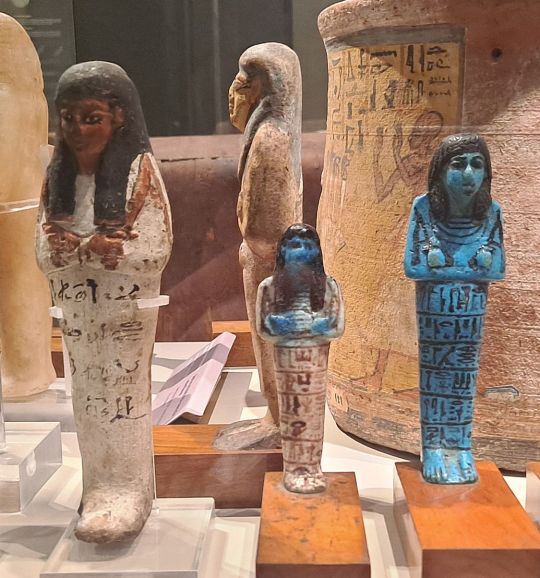
Funerary figurines
* Shabti of Paankh with inscription on cursive script. Bakerd clay, New Kingdom, 19th dynasty (1292-1190 BCE)
* Two shabtis of Userhat, scribe of Amon. Faience, New Kingdom, 19th-20th dynasty (1292-1076 BCE)
* Turin Egyptian Museum
Turin, June 2023
#Egypt#figurine#ancient#funerary#art#faience#ancient colours#13th century BCE#12th century BCE#11th century BCE#Turin Egyptian Museum#my photo
82 notes
·
View notes
Text

the anti-palestine comments are too much. how was it invented out of antisemitism when it existed long before israel? can someone please explain that one to me
#i know it was called canaan before but that doesnt erase their history or how long theyve been there#theyve been referred to as palestine since 12th century bce
4 notes
·
View notes
Text
currently obsessed with the idea that the dido we see in aeneid 1 and 4 isn't the real dido-- and not just because she's acting under the influence of venus and cupid. she's literally not the real dido, she's an eidolon, an imago.
because as vergil and his readers know, carthage was founded in 814 bce, and the trojan war ended in 1184 bce, 370 years too early for aeneas to actually run into dido. now there are a couple of ways you can deal with this: you can say that vergil moved the foundation of carthage 370 years earlier for the purposes of his story. or you can say that aeneas and his men travel to the 9th century when they go to carthage and then back to the 12th century when they leave for italy.
or you can say that actually nobody and nothing moves in time. aeneas goes to carthage in the 12th century, 370 years before it was founded by dido. he sees a mirage of a city ruled by a phantom queen. so when he goes to the underworld in book 6 and sees the shade of dido, she doesn't know him and turns aside because that's the real dido who lived and founded carthage in the 9th century and killed herself to avoid being forced to marry iarbas and never met aeneas. that's how the underworld works, it's populated by people who haven't been born yet by aeneas' time but are still there already dead. dido isn't like a ghost like anchises, she's a ghost like marcellus.
669 notes
·
View notes
Text


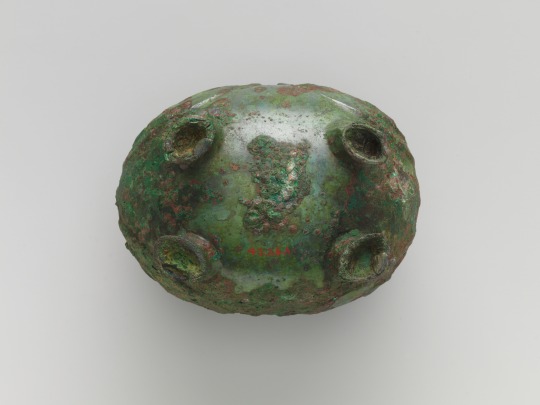

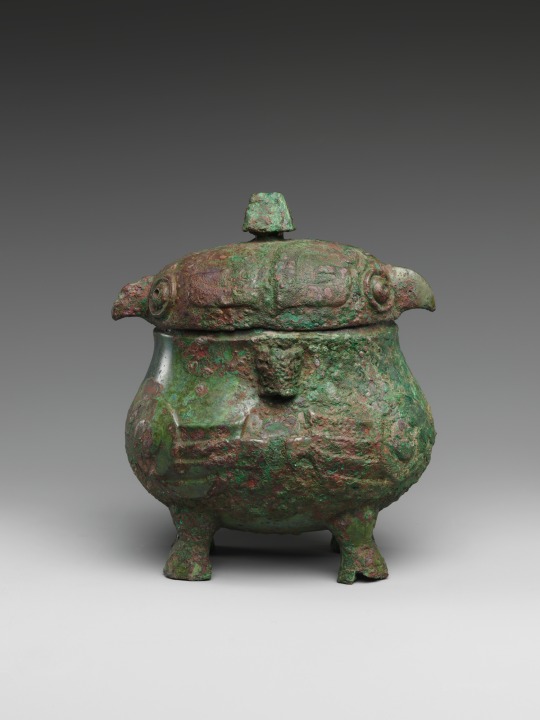
Wine cup in the shape of addorsed owls (Zhi),
China, 12th century BCE.
Bronze,H. 6 in. (15.2 cm); W. 4 in. (10.2 cm); D. 5 1/4 in. (13.3 cm),
Courtesy: The Met
#art#history#design#style#archeology#sculpture#bronze#china#owl#zhi#12th century#themet#wine cup#wine#cup
92 notes
·
View notes
Text
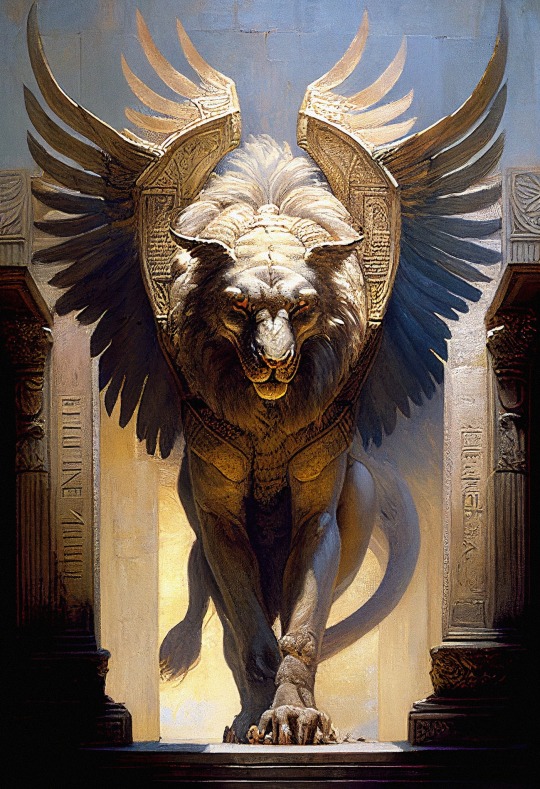
No beginning or end: it was a concept that best described the existence of Zurvan Akarana, an ancient Persian deity. He had no beginning, no end, or a specific gender (although he’s often referred to as a male) and could have been best symbolized as being “a circle of eternal life.”
Zurvan
Talon Abraxas
The earliest mentions of Zurvān appear in tablets dated to about the 13th and 12th centuries bce, found at the site of the ancient Mesopotamian city of Nuzi. Known also as the god of growth, maturity, and decay, Zurvān appeared under two aspects: Limitless Time and Time of Long Dominion. The latter emerges from Infinite Time, lasts for 12,000 years, and returns to it. Zurvān was originally associated with three other deities: Vayu (wind), Thvarshtar (space), and Ātar (fire).
Zurvān was the chief Persian deity before the advent of Zoroastrianism and was associated with the axis mundi, or the centre of the world. The most common image of Zurvān depicts a winged, lion-headed deity encircled by a serpent, representing the motion of the Sun.
38 notes
·
View notes
Photo
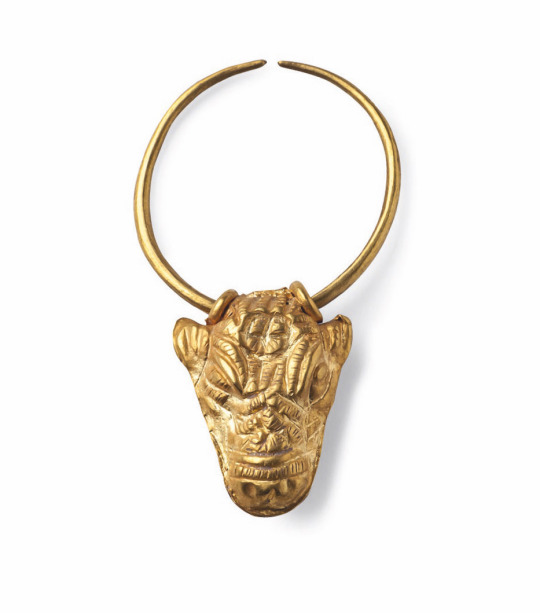
Earring, Cyprus, Late Mycenaean, 12th century BCE. The bull was a sacred animal. Via Pforzheim Jewellery Museum
250 notes
·
View notes
Photo


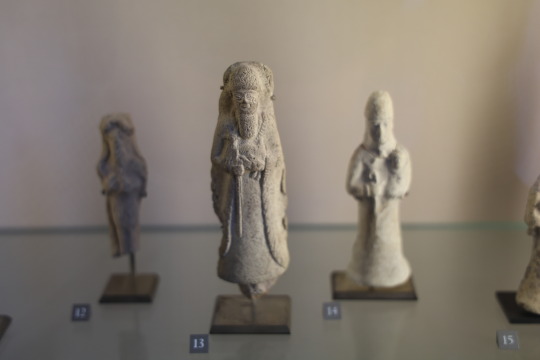

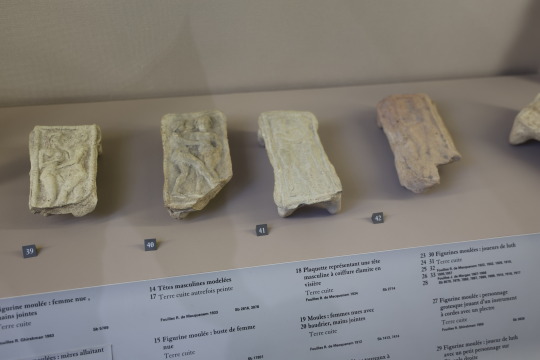
Terracottas from Susa, Iran
Middle Elamite period, 14th-12th centuries BCE
Musée du Louvre
189 notes
·
View notes
Text
Me,a starstruck 15 year old reading the Odyssey for the first time : *sighs* wish I was born in 12th century BCE so I could see Troy and-
The fucking Sea people: BRING US THE GODDAMN WARSHIPS
#pLEASE#the sea people theory haunts me in my dreams#keeps me up at night#their origins are highly disputed and we can never put exactly where they emerged from but they wrecked HAVOC#towards the end of the bronze age#egypt under ramses iii was only able to defend itself theres an entire depiction of the battle that was found#they basically destoryed so many major cities including troy#we know this becuase theres a layer of charcoal in thr ruins of troy#when you think about it actually#its very easy to see how homer wrote the illiad and odyssey#because he grew up during the dark ages of 400 years where he was surrounded by these ruins#and he was like “fuck it might as well write a fanfic”#okay#i will shut up#homer#the illiad#the odyssey#bronze age civilisation#12th century bc#sea people theory#and vampy ranting about history
59 notes
·
View notes
Text

Ritual Wine Vessel (Jue)
Chinese, 12th century BCE
For rituals, wine was served warm. The two spouts on this vessel were used to pour the warm wine into cups.
Some of the earliest belief systems in China included communicating with spirits and worshipping ancestors. Later, the philosophies and religions of Confucianism, Daoism, and Buddhism contributed their respective teachings and rituals. The interplay between these traditions over time helped define Chinese society and culture. Many rituals and ceremonies took place at an altar (in temples or homes)—it was at the altar where the human world, the natural world, and the supernatural worlds connected. So the objects that were placed on a ritual altar possess meaning and significance. The practice of conducting rituals at the altar continued in China through the Qing dynasty (1644–1911).
27 notes
·
View notes
Text
Origins of the Pibo: Let’s take a trip along the Silk Road.
1. Introduction to the garment:
Pibo 披帛 refers to a very thin and long shawl worn by women in ancient East Asia approximately between the 5th to 13th centuries CE. Pibo is a modern name and its historical counterpart was pei 帔. But I’ll use pibo as to not confuse it with Ming dynasty’s xiapei 霞帔 and a much shorter shawl worn in ancient times also called pei.
Below is a ceramic representation of the popular pibo.
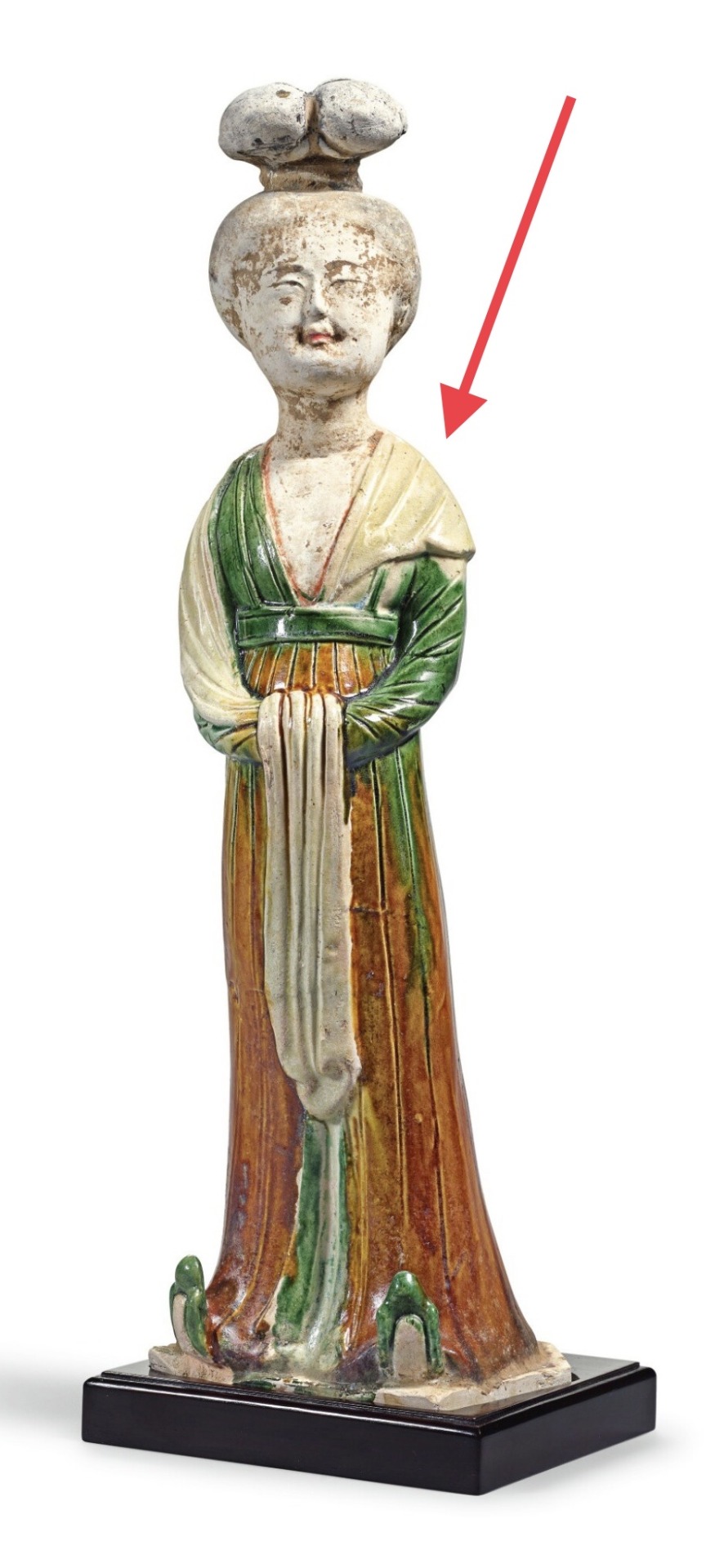
A sancai-glazed figure of a court lady, Tang Dynasty (618–690, 705–907 CE) from the Sze Yuan Tang Collection. Artist unknown. Sotheby’s [image source].
Although some internet sources claim that pibo in China can be traced as far back as the Qin (221-206 BCE) or Han (202 BCE–9 CE; 25–220 CE) dynasties, we don’t start seeing it be depicted as we know it today until the Northern and Southern dynasties period (420-589 CE). This has led to scholars placing pibo’s introduction to East Asia until after Buddhism was introduced in China. Despite the earliest art representations of the long scarf-like shawl coming from the Northern and Southern Dynasties period, the pibo reached its popularity apex in the Tang Dynasty (618–690 CE: 705–907 CE).
Academic consensus: Introduction via the Silk Road.
The definitive academic consensus is that pibo evolved from the dajin 搭巾 (a long and thin scarf) worn by Buddhist icons introduced to China via the Silk Road from West Asia.
披帛是通过丝绸之路传入中国的西亚文化, 与中国服饰发展的内因相结合而流行开来的一种"时世妆" 的形式. 沿丝绸之路所发现的披帛, 反映了丝绸贸易的活跃.
[Trans] Pibo (a long piece of cloth covering the back of the shoulders) was a popular female fashion period accessory introduced to China by West Asian cultures by way of the Silk Road and the development of Chinese costumes. The brocade scarves found along the Silk Road reflect the prosperity of the silk trade that flourished in China's past (Lu & Xu, 2015).
I want to add to the above theory my own speculation that, what the Chinese considered to be dajin, was most likely an ancient Indian garment called uttariya उत्तरीय.
2. Personal conjecture: Uttariya as a tentative origin to pibo.
In India, since Vedic times (1500-500 BCE), we see mentions in records describing women and men wearing a thin scarf-like garment called “uttariya”. It is a precursor of the now famous sari. Although the most famous depiction of uttariya is when it is wrapped around the left arm in a loop, we do have other representations where it is draped over the shoulders and cubital area (reverse of the elbow).
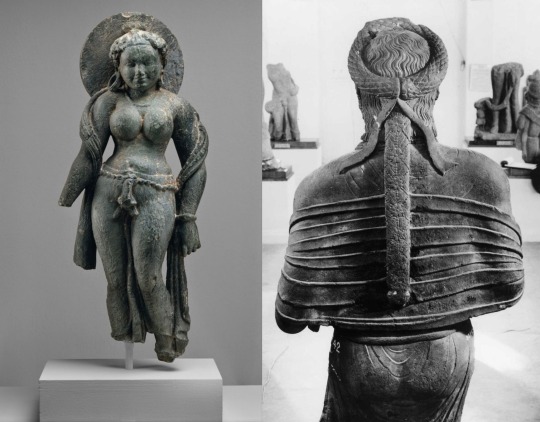
Left: Hindu sculpture “Mother Goddess (Matrika)”, mid 6th century CE, gray schist. Artist unknown. Looted from Rajasthan (Tanesara), India. Photo credit to Metropolitan Museum of Art, New York, United States [image source].
Right: Rear view of female statue possibly representing Kambojika, the Chief Queen of Mahakshatrapa Rajula, ca. 1st century CE. Artist unknown. Found in the Saptarishi Mound, Mathura, India. Government Museum, Mathura [image source].
Buddhism takes many elements from Hindu mythology, including apsaras अप्सरा (water nymphs) and gandharvas गन्धर्व (celestial musicians). The former was translated as feitian 飞天 in China. Hindu deities were depicted wearing clothes similar to what Indian people wore, among which we find uttariya, often portrayed in carvings and sculptures of flying and dancing apsaras or gods to show dynamic movement. Nevertheless, uttariya long predated Buddhism and Hinduism.
Below are carved representation of Indian apsaras and gandharvas. Notice how the uttariya are used.

Upper left: Carved relief of flying celestials (Apsara and Gandharva) in the Chalukyan style, 7th century CE, Chalukyan Dynasty (543-753 CE). Artist Unknown. Aihole, Karnataka, India. National Museum, New Delhi, India [image source]. The Chalukyan art style was very influential in early Chinese Buddhist art.
Upper right: Carved relief of flying celestials (gandharvas) from the 10th to the 12th centuries CE. Artist unknown. Karnataka, India. National Museum, New Delhi, India [image source].
Bottom: A Viyadhara (wisdom-holder; demi-god) couple, ca. 525 CE. Artist unknown. Photo taken by Nomu420 on May 10, 2014. Sondani, Mandsaur, India [image source].
Below are some of the earliest representations of flying apsaras found in the Mogao Caves, Gansu Province, China. An important pilgrimage site along the Silk Road where East and West met.
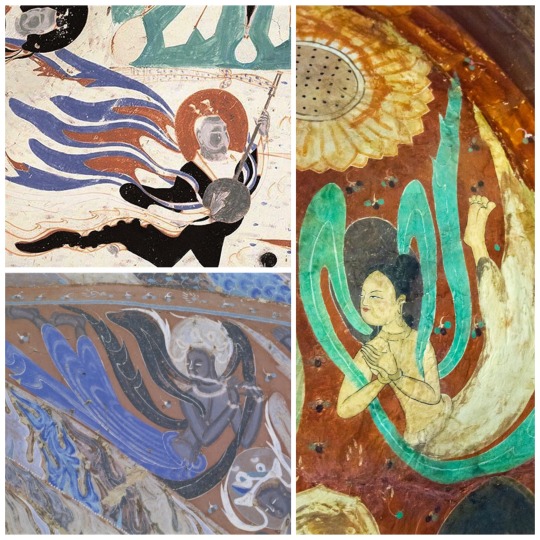
Left to right: Cave No. 461, detail of mural in the roof of the cave depicting either a flying apsara or a celestial musician. Western Wei dynasty (535–556 CE). Artist unknown. Mogao Grottoes, Dunhuang, China [image source].
Cave 285 flying apsara (feitian) in one of the Mogao Caves. Western Wei Dynasty (535–556 CE), Artist unknown. Photo taken by Keren Su for Getty Images. Mogao Grottoes, Dunhuang, China [image source].
Cave 249. Mural painting of feitian playing a flute, Western Wei Dynasty (535-556 CE). Image courtesy by Wang Kefen from The Complete Collection of Dunhuang Grottoes, Vol. 17, Paintings of Dance, The Commercial Press, Hong Kong, 2001, p. 15. Mogao Grottoes, Dunhuang, China [image source].
I theorize that it is likely that the pibo was introduced to China via Buddhism and Buddhist iconography that depicted apsaras (feitian) and other deites wearing uttariya and translated it to dajin.
3. Trickle down fashion: Buddhism’s journey to the East.
However, since Buddhism and its Indian-based fashion spread to West Asia first, to Sassanian Persians and Sogdians, it is likely that, by the time it reached the Han Chinese in the first century CE, it came with Persian and Sogdian influence. Persians’ fashion during the Sassanian Empire (224–651 CE) was influenced by Greeks (hellenization) who also had a a thin long scarf-like garment called an epliblema ἐπίβλημα, often depicted in amphora (vases) of Greek theater scenes and sculptures of deities.

Left to right: Dame Baillehache from Attica, Greece. 3rd century BCE, Hellenistic period (323-30 BCE), terracotta statuette. Photo taken by Hervé Lewandowski. Louvre Museum, Paris, France [image source].
Deatail view of amphora depicting the goddess Artemis by Athenian vase painter, Andokides, ca. 525 BCE, terracotta. Found in Vulci, Italy. Altes Museum, Berlin, Germany [image source].
Statue of a Kore (young girl), ca. 570 BCE, Archaic Period (700-480 BCE), marble. Artist unknown. Uncovered from Attica, Greece. Acropolis Museum, Athens, Greece [image source].
Detail view of Panathenaic (Olympic Games) prize amphora with lid, 363–362 BCE, Attributed to the Painter of the Wedding Procession and signed by Nikodemos, terracotta. Uncovered from Athens, Greece. J. Paul Getty Museum, Los Angeles, California, United States [image source].
Roman statue depicting Euterpe, muse of lyric poetry and music, ca. 2nd century CE, marble, Artist unknown. From the Villa of G. Cassius Longinus near Tivoli, Italy. Photo taken by Egisto Sani on March 12, 2012, Vatican Museums, Rome, Italy [image source].
Greek (or Italic) tomb mural painting from the Tomb of the Diver, ca. 470 BCE, fresco. Artist unknown. Photo taken by Floriano Rescigno. Necropolis of Paestum, Italy [image source].
Below are Iranian and Iraqi period representations of this long thin scarf.

Left to right: Closeup of ewer likely depicting a female dancer from the Sasanian Period (224–651 CE) in ancient Persia , Iran, 6th-7th century CE, silver and gilt. Artist unknown. Mary Harrsch. July 10, 2015. Arthur M. Sackler Gallery of Asian Art, Smithsonian, Washington D.C [image source].
Ewer with nude dancer probably representing a maenad, companion of Dionysus from the Sasanian Period (224–651 CE) in ancient Persia, Iran, 6th-7th century CE, silver and gilt. Artist unknown. Mary Harrsch. July 16, 2015. Arthur M. Sackler Gallery of Asian Art, Smithsonian, Washington D.C [image source].
Painting reconstructing the image of unveiled female dancers depicted in a fresco, Early Abbasid period (750-1258 CE), about 836-839 CE from Jawsaq al-Khaqani, Samarra, Iraq. Museum of Turkish and Islamic Art, Istanbul [image source].
The earliest depictions of Buddha in China, were very similar to West Asian depictions. Ever wonder why Buddha wears a long draped robe similar to a Greek himation (Romans called it toga)?
Take a look below at how much the Greeks influenced the Kushans in their art and fashion. The top left image is one of the earliest depictions of Buddha in China. Note the similarities between it and the Gandhara Buddha on the right.
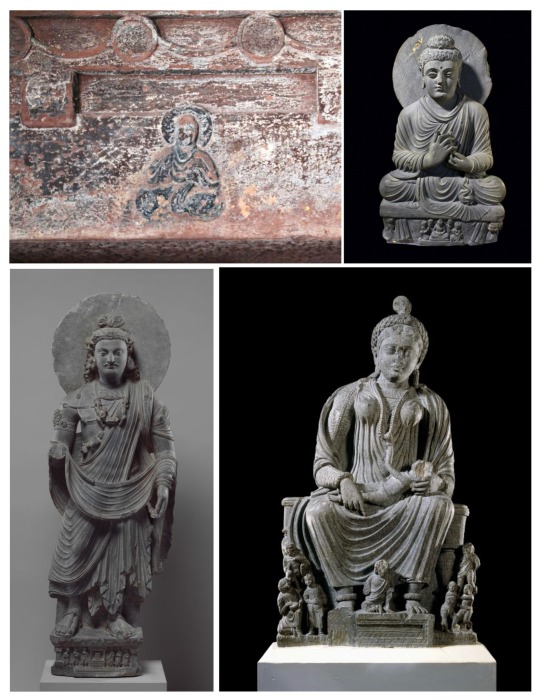
Left: Seated Buddha, Mahao Cliff Tomb, Sichuan Province, Eastern Han Dynasty, late 2nd century C.E. (photo: Gary Todd, CC0).
Right: Seated Buddha from Gandhara, Pakistan c. 2nd–3rd century C.E., Gandhara, schist (© Trustees of the British Museum)
Standing Bodhisattva Maitreya (Buddha of the Future), ca. 3rd century, gray schist. From Gandhara, Pakistan. Image credit to The Metropolitan Museum of Art, New York City, United States [image source].
Statue of seated goddess Hariti with children, ca. 2nd to 3rd centuries CE, schist. Artist unknown. From Gandhara, Pakistan. The British Museum, London, England [image source].
Before Buddhism spread outside of Northern India (birthplace), Indians never portrayed Buddha in human form.
Early Buddhist art is aniconic, meaning the Buddha is not represented in human form. Instead, Buddha is represented using symbols, such as the Bodhi tree (where he attained enlightenment), a wheel (symbolic of Dharma or the Wheel of Law), and a parasol (symbolic of the Buddha’s royal background), just to name a few. […] One of the earliest images [of Buddha in China] is a carving of a seated Buddha wearing a Gandharan-style robe discovered in a tomb dated to the late 2nd century C.E. (Eastern Han) in Sichuan province. Ancient Gandhara (located in present-day Afghanistan, Pakistan, and northwest India) was a major center for the production of Buddhist sculpture under Kushan patronage. The Kushans occupied portions of present-day Afghanistan, Pakistan, and North India from the 1st through the 3rd centuries and were the first to depict the Buddha in human form. Gandharan sculpture combined local Greco-Roman styles with Indian and steppe influences (Chaffin, 2022).
In the Mogao Caves, which contain some of the earliest Buddhist mural paintings in China, we see how initial Chinese Buddhist art depicted Indian fashion as opposed to the later hanfu-inspired garments.

Left to right: Cave 285, detail of wall painting, Western Wei dynasty (535–556 CE). Mogao Grottoes, Dunhuang, China. Courtesy the Dunhuang Academy [image source]. Note the clothes the man is wearing. It looks very similar to a lungi (a long men’s skirt).
Photo of Indian man sitting next to closed store wearing shirt, scarf, lungi and slippers. Paul Prescott. February 20, 2015. Varanasi, India [image source].
Cave 285, mural depiction of worshipping bodhisattvas, 6th century CE, Wei Dynasty (535-556 A.D.), Unknown artist. Mogao Grottoes, Dunhuang, China. Notice the half bow on his hips. That is a common style of tying patka (also known as pataka; cloth sashes) that we see throughout Indian history. Many of early Chinese Buddhist paintings feature it, including the ones at Mogao Caves.
Indian relief of Ashoka wearing dhoti and patka, ca. 1st century BC, Unknown artist. From the Amaravathi village, Guntur district, Andhra Pradesh, India. Currently at the Guimet Museum, Paris [image source].
Cave 263. Mural showing underlying painting, Northern Wei Dynasty (386–535 CE). Artist Unknown. Picture taken November 29, 2011, Mogao Grottoes, Dunhuang, China [image source]. Note the pants that look to be dhoti.
Comparison photo of modern dhoti advertisement from Etsy [image source].
Spread of Buddhism to East Asia.

Map depicting the spread of Buddhism from Northern India to the rest of Asia. Gunawan Kartapranata. January 31, 2014 [image source]. Note how Mahayana Buddhism arrived to China after passing through Kushan, Bactrean, and nomadic steppe lands, absorbing elements of each culture along the way.
Wealthy Buddhist female patrons emulated the fantasy fashion worn by apsaras, specifically, the uttariya/dajin and adopted it as an everyday component of their fashion.

Cave 285. feitian mural painting on the west wall, Western Wei Dynasty (535–556 CE). Artist unknown. Mogao Grottoes, Dunhuang, China [image source].
Cave 285. Detail view of offering bodhisattvas (bodhisattvas making offers to Buddha) next to the phoenix chariot on the Western wall of the cave. Western Wei Dynasty (535–556 CE). Artist unknown. Mogao Grottoes, Dunhuang, China [image source].
Cave 61 Khotanese (from the kingdom of Khotan 于阗 [56–1006 CE]) donor ladies, ca. 10th century CE, Five Dynasties period (907 to 979 CE). Artist unknown. Picture scanned from Zhang Weiwen’s Les oeuvres remarquables de l'art de Dunhuang, 2007, p. 128. Uploaded to Wikimedia Commons on October 11, 2012 by Ismoon. Mogao Grottoes, Dunhuang, China [image source].
Detail view of Ladies Adorning Their Hair with Flowers 簪花仕女图, late 8th to early 9th century CE, handscroll, ink and color on silk, Zhou Fang 周昉 (730-800 AD). Liaoning Provincial Museum, Shenyang, China [image source].
Therefore, the theory I propose of how the pibo entered East Asia is:
India —> Greek influenced West Asia (Sassanian Persians, Sogdians, Kushans, etc…) —> Han China —> Rest of East Asia (Three Kingdoms Korea, Asuka Japan, etc…)
Thus, the most likely theory, in my person opinion, is Buddhist iconography depicting uttariya encountered Greek-influenced West Asian Persian, Sogdian, and Kushan shawls, which combined arrived to China but wouldn’t become commonplace there until the explosion in popularity of Buddhism from the periods of Northern and Southern Dynasties to Song.
References:
盧秀文; 徐會貞. 《披帛與絲路文化交流》 [The brocade scarf and the cultural exchanges along the Silk Road]. 敦煌研究 (中國: 敦煌研究編輯部). 2015-06: 22 – 29. ISSN 1000-4106.
#hanfu#chinese culture#chinese history#buddhism#persian#sogdian#kushan#gandhara#indian fashion#uttariya#pibo#history#asian culture#asian art#asian history#asian fashion#east asia#south asia#india#pakistan#iraq#afghanistan#sassanian#silk road#fashion history#tang dynasty#eastern han dynasty#cultural exchange#greek fashion#mogao caves
283 notes
·
View notes
Text

Bronze wine vessel in the shape of an owl, late Shang dynasty, c. 13th/12th century BCE.
112 notes
·
View notes
Text
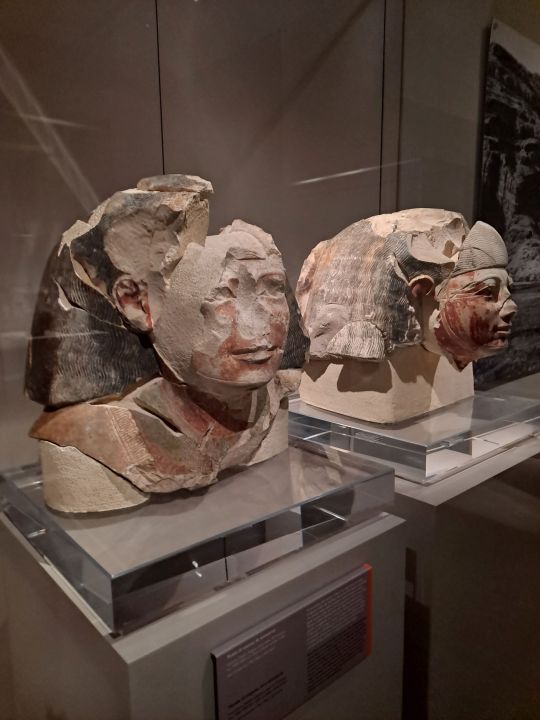

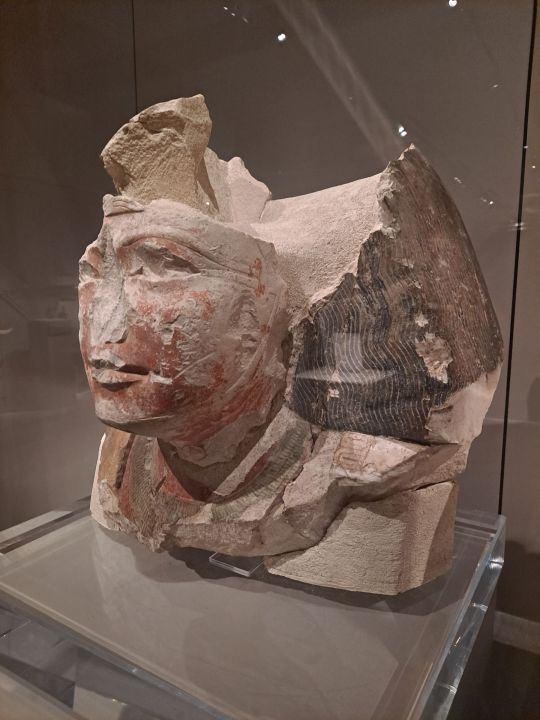
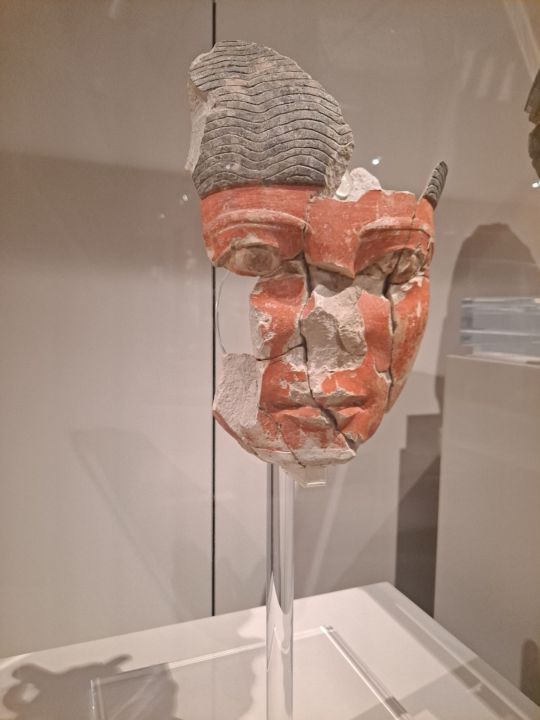
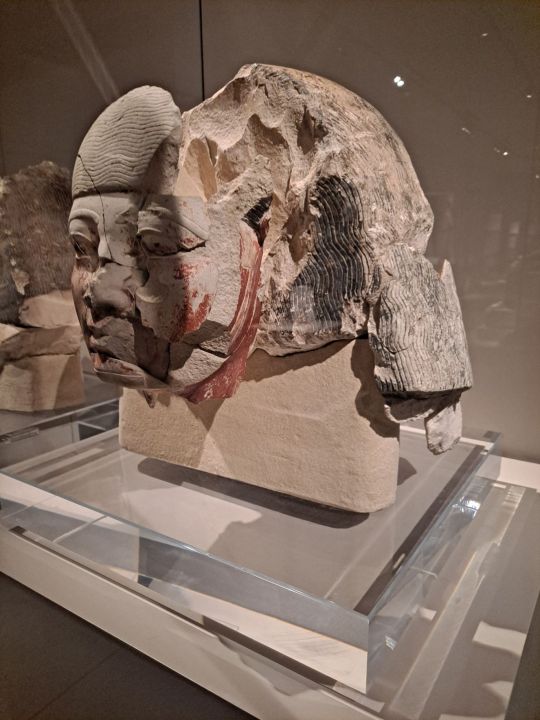

Egyptian Nomarchs (governors)
* 12th dynasty (20th century BCE)
* Antaeopolis
* Turin Egyptian Museum
Turin, June 2023
#Egypt#20th century BCE#governor#ancient#art#head#ancient colours#eye#Turin Egyptian museum#my photo
77 notes
·
View notes
Photo

Philistines
The Philistines populated the coastal regions of Canaan from the 12th century BCE to their disappearance in 604 BCE. The word "Philistine" derives from the Hebrew ha-Plištim for the combination of several tribes of Syria and Judea with the older name "Syria-Palestina". The Latin word for the lands of Canaan became "Palestine" after the Bar-Kochba Revolt (132-136 CE) during the reign of the Roman emperor Hadrian (r. 117-138 CE). The term "Philistine" has come to mean someone uneducated and lacking in culture from the stories concerning them in the Jewish Scriptures.
Learn more about Philistines
62 notes
·
View notes
Text


A Circle of Eternal Life
No beginning or end: it was a concept that best described the existence of Zurvan Akarana, an ancient Persian deity. He had no beginning, no end, or a specific gender (although he’s often referred to as a male) and could have been best symbolized as being “a circle of eternal life.”
'Zurvān'
Talon Abraxas
The earliest mentions of Zurvān appear in tablets dated to about the 13th and 12th centuries bce, found at the site of the ancient Mesopotamian city of Nuzi. Known also as the god of growth, maturity, and decay, Zurvān appeared under two aspects: Limitless Time and Time of Long Dominion. The latter emerges from Infinite Time, lasts for 12,000 years, and returns to it. Zurvān was originally associated with three other deities: Vayu (wind), Thvarshtar (space), and Ātar (fire).
Zurvān was the chief Persian deity before the advent of Zoroastrianism and was associated with the axis mundi, or the centre of the world. The most common image of Zurvān depicts a winged, lion-headed deity encircled by a serpent, representing the motion of the Sun.
53 notes
·
View notes
Photo
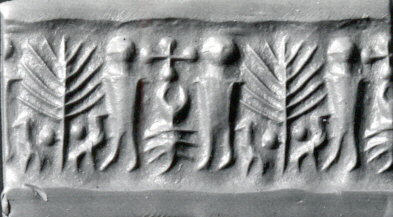
Cylinder seal. ca. 15th–12th century BCE. Credit line: The Cesnola Collection, Purchased by subscription, 1874–76 https://www.metmuseum.org/art/collection/search/321427
#aesthetic#art#abstract art#art museum#art history#The Metropolitan Museum of Art#museum#museum photography#museum aesthetic#dark academia
10 notes
·
View notes
Text
Just gonna go ahead and say it. Since so many people are missing the nuance.
The reason so many Western powers do nothing to stop Israel is because it means admitting their own antisemitism was a driving force behind Israel's very creation.
Literally every country/kingdom/empire in which the Jewish people have lived, throughout history, has villified them and tried to kill them, cast them out or some combination of both. The very reason there are Jewish people across Europe is because the Roman empire found them to be too hard to manage in large numbers as they did not respect Roman authority. So the Diaspora or "dispersement" happened repeatedly and the middle eastern Jewish population was spread across Europe as far west as the UK and as far east as Russia.
Antisemitism was running rampant in the UK, the US and many other places before Hitler came along. The very reason that there is a stereotype about Jewish bankers, is because for a very long time (particularly in England) they weren't allowed to work most jobs in most fields. Their options were limited, and lending (not borrowing) money is not allowed by the Roman Catholic Church, which ruled over England from the 6th century to 1534. A thousand years of being a nation's only bankers is going to make you rich, but when times got hard economically, the British began to default on their debts and the stereotype of the "greedy jew" was born from this.
Antisemitism is thousands of years old and the aforementioned countries and others were looking for a way to deal with this "problem" and the idea of giving them their own country to go live in. So they leave yours, was presented and initially rejected, until Hitler came along. What the Nazis did allowed for this idea to move forward, now with the entire world feeling sympathetic to the horrors the Jewish people endured under their occupation.
Uganda was actually the original site planned in 1905, but their government and WHITE settlers their fought tooth and nail until another site was chosen, Palestine.
People seem to think Israel has always existed, but that is simply not the case. The word Palestine derives from Philistia, the name given by Greek writers to the land of the Philistines who in the 12th century BCE occupied a small pocket of land on the southern coast, between modern Tel-Aviv-Yafo and Gaza. The name was revived by the Romans in the 2nd century CE in “Syria Palaestina,” designating the southern portion of the province of Syria, and made its way thence into Arabic, where it has been used to describe the region at least since the early Islamic era. The Romans literally wiped Judea off the map, reduced it to rubble, before renaming it, and it stayed that way for the next 400 years.
Around 30% of the Palestinian population was already Jewish and living in relative peace before 1948. They could've easily increased their numbers without drawing new borders, but the Jewish lead British government (the Rothschilds and others already had their hands in everyone's pockets at this point) made it clear in 1917 with the Balfour declaration, that they intended to take Palestine from the Ottoman empire during WW1, and designate it the Jewish homeland. Actually, as soon as the war kicked off, British War Cabinet member and zionist Herbert Samuel proposed the government express support for zionist ambitions in order to gain more Jewish support (money and soldiers) for the ongoing world war. This effort continued through to WW2, finally gaining global support upon the world's realization of Hitler's atrocities.
This situation is anything but black and white.
23 notes
·
View notes